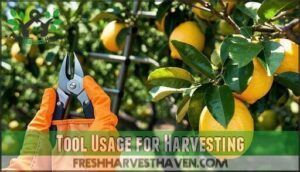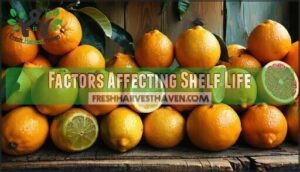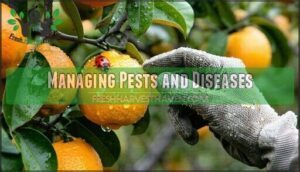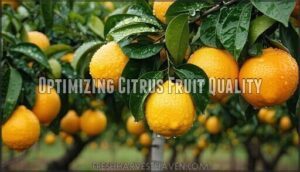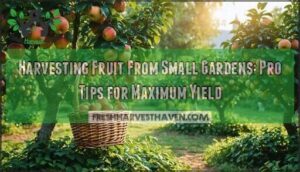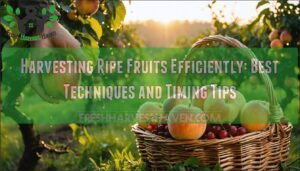This site is supported by our readers. We may earn a commission, at no cost to you, if you purchase through links.
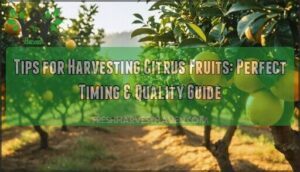 Successful tips for harvesting citrus fruits start with timing – wait until fruits develop full color and feel firm but give slightly when pressed.
Successful tips for harvesting citrus fruits start with timing – wait until fruits develop full color and feel firm but give slightly when pressed.
Don’t rely on color alone; taste-test a sample fruit since citrus can look ripe before reaching peak sweetness.
Harvest during dry weather to prevent disease spread, and use clean pruning shears rather than pulling fruits by hand to avoid damaging the tree.
Pick fruits with stems attached when possible, as this extends storage life.
Morning harvests often yield better quality since fruits are cooler and less stressed.
The secret lies in understanding each variety’s unique ripening signals and storage requirements.
Table Of Contents
- Key Takeaways
- Harvest Timing Considerations
- Identifying Ripe Citrus Fruits
- Harvesting Techniques Matter
- Factors Affecting Shelf Life
- Managing Pests and Diseases
- Optimizing Citrus Fruit Quality
- Frequently Asked Questions (FAQs)
- How to properly pick citrus?
- Should you pick all the fruit off citrus trees?
- How do you encourage citrus branching?
- How do you harvest citrus fruits?
- How do I know when my citrus fruit is ready to pick?
- How to pick good citrus?
- Should you harvest fruit from a citrus tree?
- When should you harvest citrus fruits?
- How do you pick citrus fruit if it’s too ripe?
- Can you pull citrus off a tree?
- Conclusion
Key Takeaways
- Time your harvest right – Don’t pick based on color alone; wait until fruits feel heavy for their size and yield slightly to gentle pressure, then taste-test one to confirm peak sweetness.
- Use proper tools and technique – Cut stems cleanly with sharp pruning shears rather than pulling fruits by hand, which damages both the fruit and tree branches.
- Harvest during optimal conditions – Pick fruits during dry weather and cooler morning hours to prevent disease spread and reduce fruit stress.
- Store correctly for maximum shelf life – Keep harvested citrus at 41-50°F with 85-95% humidity in breathable containers, which extends freshness from days to weeks.
Harvest Timing Considerations
You’ll get the best fruit when you harvest citrus at the right time based on your local growing conditions and variety-specific schedules.
Timing depends on peak harvest seasons, weather patterns, and proper disease management to guarantee maximum quality and shelf life.
Peak Harvest Seasons
Since mastering citrus harvesting tips requires understanding seasonal rhythms, knowing your peak harvest seasons guarantees you’ll capture fruit at mature perfection.
Regional variations substantially impact timing—California’s citrus harvest season typically runs December through March, while Florida’s extends into summer months.
Here’s when different varieties reach their prime:
- Navel oranges: Peak November to June, with December through February offering the sweetest harvesting citrus opportunities
- Valencia oranges: March to October harvest window, perfectly complementing navel orange seasons for year-round availability
- Grapefruits and tangerines: November through May delivers peak flavors, though variety differences create specific timing windows
Climate influence affects ripening by weeks or months between regions.
Citrus has a rich history, including being given as winter holiday gifts due to their seasonal availability.
Harvest delays beyond mature timing reduce quality and increase fruit drop, making proper seasonal planning essential for ripe citrus.
Weather Impact on Ripeness
Weather dramatically affects your citrus harvest timing and fruit quality.
Temperature fluctuations between 22-34°C optimize ripening, while higher temperatures accelerate growth but reduce sugar accumulation.
Rainfall effects can dilute flavors if excessive during fruit development, though adequate moisture after hot summers supports healthy growth.
Sunlight exposure helps fruits achieve proper color and sugar content through natural processes.
However, frost damage poses serious risks—freezing temperatures can destroy entire crops overnight.
Regional variations create different harvest windows, with tropical climates producing sweeter fruit than Mediterranean regions.
Monitor weather patterns closely, as they’re your best citrus ripeness test indicator for determining ideal harvest timing, considering the impact of temperature fluctuations and the importance of sunlight exposure.
Disease Control Measures
Although weather affects ripening, disease control protects your harvest investment. Implement bacterial management and fungal prevention before picking starts. Viral threats spread quickly, so remove infected fruit immediately and maintain clean orchard conditions.
Citrus disease prevention includes controlling pests that create entry points for infections. Prevention strategies work better than treatment options after problems start. Focus on citrus pest prevention and citrus fungus prevention through regular inspections.
Watch for the Asian Citrus Psyllid, which spreads fatal disease. The psyllid transmits the bacteria causing citrus Huanglongbing.
Don’t forget citrus root rot prevention – healthy roots support natural disease control systems that keep trees productive.
- Soil sanitation around tree bases prevents pathogen buildup that threatens root health and overall tree immunity
- Sanitized clippers eliminate cross-contamination between trees during pruning and harvesting operations
- Regular monitoring helps catch early signs of infection before they spread throughout your grove
Identifying Ripe Citrus Fruits
You’ll know your citrus is ready when the color develops fully and the fruit feels heavy for its size.
Each variety has its own telltale signs, so learning these specific cues will help you pick at peak ripeness every time.
Color Indicators
Color development in citrus fruits begins when chlorophyll breakdown reveals underlying carotenoid pigments.
You’ll see oranges turning from green to bright orange, lemons becoming golden yellow, and grapefruits developing pink blushes.
However, don’t rely solely on color—variety variance means some ripe citrus maintains green patches.
Valencia oranges often stay greenish despite being perfectly ripe.
Use color as one indicator among several when harvesting citrus and determining ripeness. A sweet aroma, indicating peak fruit ripeness, can also help.
Size and Shape Factors
While color catches your eye first, the physical dimensions of citrus fruits reveal their true readiness for harvest. Mature citrus reaches full size and develops characteristic shape before ideal picking time arrives.
Size Standards serve as your primary guide. Ripe fruits feel noticeably heavy for their dimensions due to concentrated juice content. Each variety has specific Optimal Dimensions that match Market Standards – oranges achieve roundness while lemons display their signature elongated form.
Check these key indicators:
- Varietal Size: Compare your fruit against expected dimensions for the specific citrus type
- Fruit Symmetry: Look for uniform, well-developed specimens without lopsided appearance
- Shape Deformities: Avoid misshapen fruits that indicate poor development or stress
Citrus Fruit Size should align with variety expectations, while Citrus Fruit Shape appears balanced and full. This Citrus Fruit Symmetry signals proper maturation and peak juice development, ensuring you harvest at the perfect moment for maximum flavor and storage potential.
Variety-Specific Ripeness
Understanding variety-specific ripeness prevents disappointment at harvest time.
Different citrus varieties display unique maturity signals that you’ll learn to recognize.
| Variety | Key Ripeness Indicator | Harvest Timing |
|---|---|---|
| Navel Oranges | "Belly button" formation | November-June |
| Blood Oranges | Deep crimson interior | December-March |
| Meyer Lemons | Golden-yellow with orange tinge | Year-round |
Navel Oranges develop their signature navel when ready, while Blood Oranges transform from orange to crimson.
Lemon Ripeness shows bright yellow coloring, but Lime Varieties often harvest green for tartness.
Tangerine Maturity appears through even orange coloring, though citrus varieties differ substantially.
These ripeness indicators help assess citrus fruit maturity accurately for ideal harvest timing.
Harvesting Techniques Matter
You’ll harvest the best citrus when you use the right techniques that protect both fruit and tree.
Perfect timing and gentle handling make all the difference in citrus harvesting success.
Clean cuts with sharp tools prevent damage, while gentle handling preserves quality from branch to storage.
Hand Picking Methods
When harvesting citrus, gentle handling protects both fruit and trees from unnecessary damage. Proper technique guarantees maximum yield while preventing costly mistakes that reduce future harvests.
Essential Hand Picking Steps:
- Cup the fruit completely in your palm before attempting removal
- Twist gently while applying slight upward pressure to loosen naturally
- Break the stem cleanly using your thumb for precise separation
- Place carefully in your container to avoid bruising during collection
This citrus harvesting guide emphasizes controlled movements over forceful yanking. Preventing damage starts with proper handling techniques that protect bark integrity.
Using specialized hand protection can also improve grip and prevent scratches. Gentle harvesting methods guarantee stem cutting occurs naturally without tearing branches, maintaining tree health for future seasons.
Tool Usage for Harvesting
When reaching for those perfect citrus fruits, citrus clippers and pruning shears deliver clean cuts that protect both fruit and tree.
Telescoping pole pickers with cushioned bag liners safely harvest high branches without ladders, though ladder safety requires three-point contact when necessary.
Clipper sanitation prevents disease spread—clean tools between trees.
Shears vs. hands isn’t even close; tools win every time by preventing branch damage and fruit bruising.
Citrus harvesting tools like specialized citrus fruit removal clippers reduce handling time while maintaining quality.
Choose anvil-action clippers for thick stems, bypass pruners for delicate varieties.
Telescoping pole pickers with cushioned baskets minimize drops and bruising, making your harvest both efficient and gentle on the fruit.
Lightweight tools help to reduce user fatigue, especially during extended use.
Post-Harvest Handling
Transform your freshly picked citrus into a long-lasting harvest by mastering proper postharvest handling techniques. Your careful attention now determines whether your fruits stay fresh for days or weeks.
Key citrus fruit storage steps:
- Cooling Techniques: Immediately chill fruits to 45-50°F to slow spoilage and maintain quality
- Sanitation Practices: Clean tools and containers with approved sanitizers to prevent disease spread
- Packaging Materials: Use breathable containers with ventilation holes, avoiding plastic bags that trap moisture
Handle fruits gently when transferring to shallow containers. Sort by Grading Standards, separating damaged fruits to prevent rot spread.
Control temperature and humidity levels in storage areas – aim for 85-90% humidity to prevent dehydration. Consider specialized equipment needs for ideal results.
Your Storage Duration depends on these factors:
- Room temperature: one week maximum
- Refrigerated: 2-3 weeks in perforated bags
- Controlled atmosphere: several months for commercial operations
Proper postharvest handling extends shelf life substantially while preserving that just-picked flavor you worked hard to achieve.
Factors Affecting Shelf Life
Once you’ve picked your citrus fruits, proper storage becomes critical for maintaining quality and extending their usable life.
Temperature control, humidity management, and storage conditions directly determine whether your harvest stays fresh for days or weeks.
Temperature Control
Store your harvested citrus at 41-50°F for maximum shelf life.
Your citrus harvest stays fresh for weeks instead of days with proper 41-50°F storage.
This ideal range prevents chilling injury while slowing decay – your fruit stays fresh for weeks instead of days.
Use cooling methods like refrigeration, but avoid temperatures below 32°F which damage citrus.
Transportation temperatures should remain consistent since sudden changes stress fruit.
Install climate monitoring systems to track fluctuations.
Proper citrus fruit thermal regulation and postharvest citrus storage create ideal conditions for extended storage duration.
For other produce, consider refrigeration best practices to maintain freshness.
Humidity Levels
Managing humidity levels between 85-95% prevents moisture loss while stopping mold prevention issues.
Your citrus will shrivel in dry air or develop rot when too damp.
Humidity impact on citrus fruit storage conditions requires careful balance.
- Use perforated plastic bags for citrus fruit humidity control
- Place damp paper towels in containers to maintain storage humidity
- Guarantee proper ventilation to prevent citrus fruit spoilage
- Monitor humidity effects regularly to avoid quality loss.
Proper ventilation balances these ideal ranges for extended freshness.
Storage Conditions
Beyond humidity control, your citrus storage environment needs strategic planning for ideal temperature and ventilation needs.
Create the perfect storage setup by maintaining consistent conditions between 45-55°F with excellent air circulation.
Your postharvest handling success depends on proper packaging solutions that prevent moisture buildup while allowing airflow.
Smart storage practices deliver impressive shelf-life extension results:
- Use shallow containers with ventilation holes instead of deep bins that trap heat
- Separate damaged fruits immediately to prevent rapid spoilage spread
- Avoid plastic bags that create moisture traps and accelerate decay
- Position storage areas away from direct sunlight and heat sources
- Check stored fruits weekly to remove any showing early deterioration signs
Professional growers know that temperature control and humidity levels work together.
Your storage conditions directly impact shelf life – fruits stored properly last 2-3 weeks versus just days at room temperature.
Breathable packaging solutions maintain the protective wax layer while preventing dehydration.
Managing Pests and Diseases
You can’t ignore pests and diseases when harvesting citrus fruits since they directly affect both fruit quality and tree health.
The key is preventing problems before they reach your harvest, using targeted organic methods first and chemical controls only when necessary.
Common Citrus Pests
Your citrus trees face several threatening pests during harvest season.
Citrus red mites cause severe defoliation and pale fruit, with populations peaking in high temperatures.
Brown citrus aphids transmit deadly viruses while stunting growth and reducing fruit set.
Purple scale insects create yellow leaf spots and fruit discoloration, thriving in shaded canopy areas.
Fruit flies lay eggs inside citrus, making them unmarketable.
Early citrus fruit pest identification and pest damage signs recognition enable effective pest management through natural predators and preventative measures.
Organic Pest Control Methods
You’ll protect your citrus trees most effectively with organic pest control methods that work with nature rather than against it.
Beneficial insects like lady beetles and parasitic wasps become your frontline defenders, naturally controlling aphids and scale insects without chemical intervention.
Organic sprays including neem oil and insecticidal soaps disrupt pest feeding cycles while keeping your fruit safe for consumption.
Companion planting with marigolds creates a natural barrier that repels harmful insects while attracting natural predators to your orchard.
Strong soil health through proper composting and organic matter builds tree immunity against common pests.
Effective solutions include products for pest control.
These citrus fruit organic solutions protect your harvest while maintaining environmental balance.
Chemical Pest Control Options
While organic methods work well for mild infestations, chemical pest control becomes necessary when pests overwhelm your citrus trees.
Pesticide application requires careful planning to maximize effectiveness while minimizing environmental impact and protecting worker safety. Modern citrus fruit chemical solutions offer targeted approaches that complement organic pest control methods.
Chemical resistance develops when you rely on single products, so rotation prevents this costly problem. Regulatory compliance guarantees your harvest meets safety standards for market acceptance.
To further bolster your defenses, consider companion planting strategies to naturally repel pests.
Here are four strategic approaches for effective chemical pest control:
- Rotate between neonicotinoids and pyrethroids to prevent citrus fruit pest resistance development
- Apply during cooler morning hours when beneficial insects remain inactive and spray drift reduces
- Choose systemic insecticides for severe infestations that penetrate plant tissues for lasting protection
- Combine with citrus fruit organic solutions** through integrated pest management for sustainable results
Always follow label instructions precisely and consider environmental conditions before application.
Optimizing Citrus Fruit Quality
You’ll get the best-tasting citrus when you focus on maximizing sugar content and flavor compounds right before harvest.
The key is understanding how ripening processes work and managing nutrients throughout the growing season to enhance natural fruit quality.
Ripening Processes
Mother Nature orchestrates citrus fruit ripening through four interconnected processes that determine when you’ll taste peak flavor. Chlorophyll breakdown comes first, dissolving green pigments to reveal the bright oranges, yellows, and reds beneath. Meanwhile, sugar conversion transforms starches into natural sweetness that makes your mouth water.
As ripening progresses, acid reduction balances the tartness, creating that perfect sweet-tart profile citrus lovers crave. Aroma development releases those fragrant oils that signal maturity—you’ll notice fruits becoming more fragrant as they ripen.
Ripening duration varies dramatically: oranges need 12-15 months while grapefruits require up to 18 months. Since citrus fruit sweetness won’t improve after picking, understanding these ripening processes helps you time your harvest perfectly for maximum citrus fruit flavor.
Flavor Enhancement Techniques
Understanding ripening processes sets the foundation for taking your citrus fruit flavor to the next level. You can actively enhance sweetness boosting and aroma development through proven techniques that work with your tree’s natural biology.
Strategic flavor enhancement starts with environmental control. Temperature fluctuations between cool nights and warm days naturally increase sugar accumulation while promoting better citrus fruit aroma. This contrast triggers the tree’s stress response, concentrating flavors and improving the overall taste profile.
Here are three key techniques for maximizing citrus fruit flavor:
- Selective pruning – Remove competing branches around fruit clusters to increase sun exposure, which directly improves citrus fruit sweetness and acidity balancing
- Foliar feeding – Apply diluted seaweed or kelp solutions bi-weekly to support natural flavor development and enhance citrus fruit acidity
- Water stress timing – Reduce irrigation slightly during final ripening weeks to concentrate sugars and intensify flavor compounds
Remember that post-harvest curing won’t work since citrus doesn’t continue ripening after picking. Your window for flavor enhancement closes at harvest, making these pre-harvest techniques your only opportunity to maximize taste quality.
Nutrient Management for Quality
Five key nutrients directly impact your citrus fruit quality through strategic nutrient management. Soil testing reveals exactly what your trees need for ideal citrus fruit flavor enhancement.
Potassium increases fruit size and sweetness, while boron acts as a sugar transporter, improving juice content. Calcium strengthens cell walls for better shelf life.
| Nutrient | Primary Benefit | Deficiency Symptoms |
|---|---|---|
| Potassium | Larger, sweeter fruit | Small fruit, poor color |
| Boron | Sugar transport, juice content | Lumpy, cracked fruit |
| Calcium | Firmness, disease resistance | Soft, misshapen fruit |
Fertilizer types should match your soil’s pH between 5.5-6.5 for maximum uptake. Organic amendments like compost improve citrus fruit soil health naturally.
Proper irrigation practices help nutrients reach roots effectively, preventing common citrus fruit nutrient management mistakes that reduce quality.
Frequently Asked Questions (FAQs)
How to properly pick citrus?
Like a treasure hunter approaching a golden orb, you’ll want to use sharp pruning shears to cut the stem cleanly.
Rather than pulling the fruit, which can damage the tree and reduce future harvests.
Should you pick all the fruit off citrus trees?
You shouldn’t pick all the fruit at once.
Harvest gradually as fruits ripen, since citrus doesn’t ripen after picking.
Leave unripe fruit on the tree to develop full flavor and sweetness naturally.
How do you encourage citrus branching?
Young citrus trees produce 30% more branches when pruned correctly.
You’ll encourage branching by pinching growing tips, making cuts above outward-facing buds, and pruning during dormancy.
Light pruning stimulates lateral growth while heavy cuts promote vigorous shoots.
How do you harvest citrus fruits?
Use sharp, clean pruning shears to cut fruit at the stem—never pull or twist.
Harvest when fruit’s fully colored and feels heavy for its size.
Work after morning dew dries to prevent disease spread.
How do I know when my citrus fruit is ready to pick?
Check your citrus fruit’s color – it should be vibrant with no green patches.
The fruit feels heavy for its size and yields slightly to gentle pressure.
Taste-test one; ripe citrus has balanced sweetness and developed flavor, with ripe citrus being the key to a great taste.
How to pick good citrus?
Good citrus feels heavy for its size and yields slightly to gentle pressure.
The skin should show full color without green patches, and ripe fruit practically falls into your hand with minimal effort.
Should you harvest fruit from a citrus tree?
Like a treasure hanging just within reach, you should absolutely harvest citrus when it’s ripe.
Don’t let perfectly good fruit go to waste on the tree—harvest when fully colored and heavy for superior flavor and quality.
When should you harvest citrus fruits?
Harvest citrus when fruits develop their characteristic color, feel heavy for their size, and yield slightly to pressure.
Most varieties ripen between fall and early spring, depending on type and region, which is a complete concept to consider when planning.
How do you pick citrus fruit if it’s too ripe?
Unfortunately, citrus fruits don’t ripen after picking, so overripe fruit on the tree requires careful handling.
Use clean pruning shears to cut the stem, avoiding pulling or twisting which damages both fruit and tree branches.
Can you pull citrus off a tree?
You shouldn’t pull citrus directly off trees since it damages both fruit and branches.
Instead, use pruning shears to cut the stem cleanly, or twist gently if necessary.
Pulling tears bark and reduces future harvests.
Conclusion
Picture yourself walking through your citrus grove on a crisp morning, basket in hand, ready to collect nature’s golden treasures.
Mastering these tips for harvesting citrus fruits guarantees you’ll enjoy peak flavor and maximum storage life from every piece of fruit you pick.
You’ll know exactly when each variety reaches perfect ripeness, how to handle them properly, and the best storage methods to keep them fresh.
With proper timing, technique, and care, your homegrown citrus will deliver exceptional taste and quality for weeks to come.





